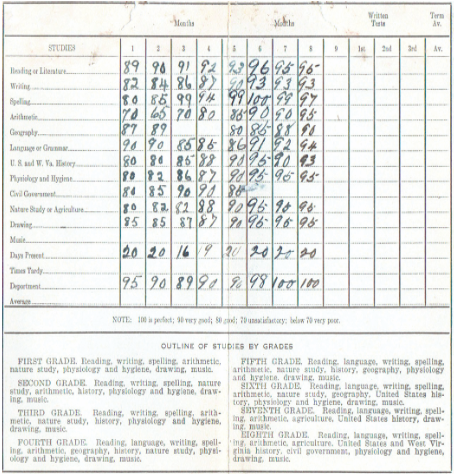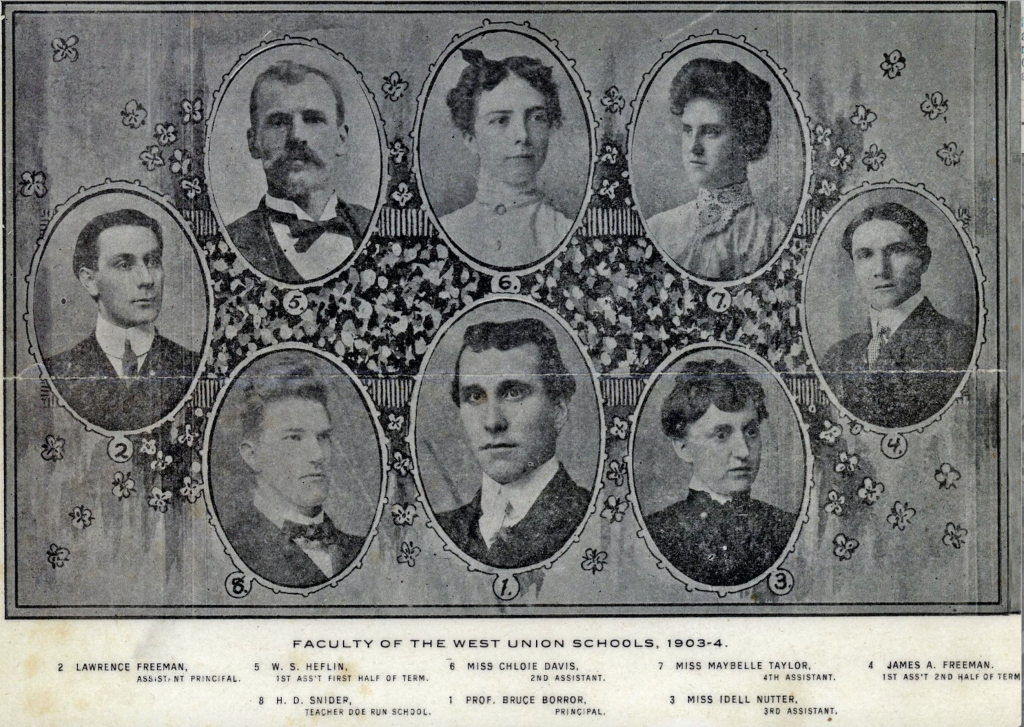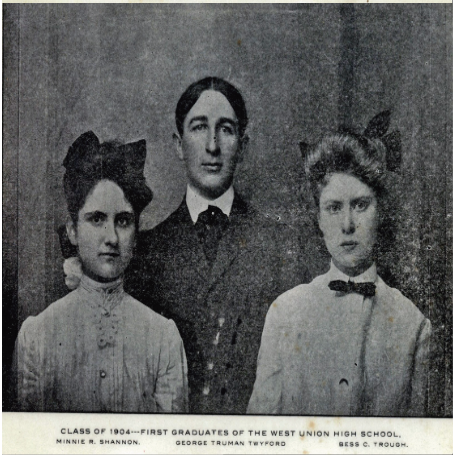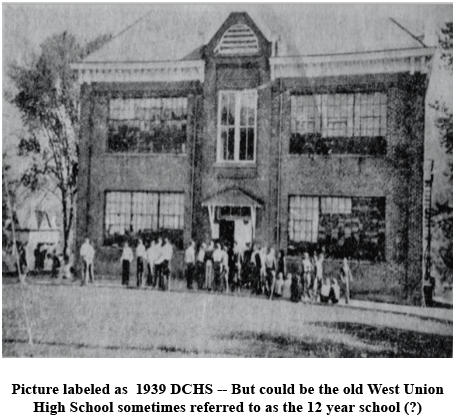Education In The Early Years of Doddridge & WV-Part 2
Last week we covered early education up to the turn of the 20th century. By now, one-room schoolhouses dotted the Doddridge County landscape. One could be found generally within three or four miles of most students who attended. This was important because most of the students had to walk to and from school each day. Some reported walking as much as five miles each way for the privilege of receiving their education. The schoolhouses were in most cases cheaply constructed with rough cut frames holding it together. The roofs were usually covered with tin and lap siding covered the exterior walls. The windows were usually installed on the south side of the structure to allow the entry of maximum sunlight. Outside the schoolhouse was most often a coal house, a well from which to draw drinking water, and out-houses were built (one for each sex).
The textbooks most relied upon in the early years included the McGuffey Reader, Ray’s Arithmetic, the Elson Reader, and Mitchell’s Geography. Writing paper was quite expensive and scarce in the more rural areas, which forced students to frequently work at the blackboard or on their small personal hand-held slates at their desks. Most of us can still remember beginning our school day with the Lord’s Prayer, Pledge of Allegiance, and perhaps a patriotic song or two.
The teacher spent much of the remainder of the school day teaching small groups of students ranging from 1st grade to 8th grade. Many times, the older student (some of whom were bigger than the teacher) helped the younger ones when they needed it.
Teacher’s salaries were not ideal at that time. Ninety-three-year-old teacher, Martha Dotson, from Greenwood recalled in 1979 that in 1909 she had 42 students in all grades at the Montgomery School on Long Run and was paid a monthly salary of $27. From that she paid $8 for board. Ray Hudkins taught his first term at the Gains School on the left fork of Upper Arnolds Creek in 1910. His monthly salary was $30. Both salaries were less than the $47.08 national average for teachers making it difficult for the county to compete for qualified teachers.
During the Great Depression of the 1930s, both money and teaching jobs were scarce. This money scarcity was one of the reasons for the passage of the County Unit System. Under the reorganization, one board of five members was responsible for all the schools.
The first five board members were James F. Foley, V. B. Lowther, Ross M. Allen, Dr. E. T. Wetzel and J. Clyde Phillips. W. B. Swentzel was superintendent until the end of his elected term in 1934. His salary was $1,700 per year. W. B. VanScoy became the first appointed superintendent of schools in 1935 with a salary of $2,700 per year.
An average school day usually included a morning recess and an afternoon recess. Students enjoyed playing such games as “Ante Over,” “London Bridge,” “Round the Mulberry Bush,” “Kick the Can,” “Hide and Seek,” and many more. If you don’t know these games, ask your parents or grandparents, they’ll most likely remember them. Lunch, which was prepared at home and often carried to school in a tin lard bucket, was given a full hour.
Although there were horse-drawn “school hacks” or “kid hacks” as early as 1886 in London, England, this was not the case for Doddridge County, or for America. Most students walked to school or were dropped off by a parent in a buckboard wagon or buggy.
Did you know that when the school bus first came on the scene in 1914 with Wayne Works building the motorized carriage much like you see today, it was not required to be painted yellow? Some states considered painting their school busses red, white, and blue to encourage patriotism for their students. Still, other states considered orange for their school busses, noting the color made the buses more visible, thus safer. The nationally recognized “National School Bus Glossy Yellow, or Color 13432 in the Federal Standard 595A color collection that GSA uses for government procurement did not become mandated for all school buses in the United States until 1939 at a conference held to develop school bus standards at the University of Manhattan, NY.
In the 1930s, both the rise of the school bus and the decline in rural population brought the beginning of the end for one-room schools. In 1933 alone, Doddridge County lost 24 of its one-room schools. By the mid-1950s, most one-room schools were closed. Their students were consolidated into larger more well-equipped schoolhouses. Parents and citizens in general feared the closing of their small school would be the end of their community as they knew it because the school was their center for not only education, but for social, dramatic, political, and religious activity as well. They did appreciate the free textbooks that were made available in the 1950s.
Still, other reasons for the demise of our romanticized one-room schools included better road conditions making school bus travel quicker and easier, as well as the need for more adequately trained teachers (eight grade graduates who passed a test earning them a teaching certificate was no longer satisfactory). The fact that many of the one-room schools were poorly equipped and in less than satisfactory locations added to their demise.
Krenn School located on 18 south near New Milton closed in 1946 and is Doddridge County’s only surviving one-room schoolhouse which is completely intact. It is a beacon of light that shines on those bygone days. It is owned and maintained by the Doddridge County Historical Society who allows it to be used by the community for special events and occasions. Much has been written about the Krenn School and I shall not repeat what has already been published in this newspaper regarding it.
Just imagine that in 1900, there were only 25 public high schools in the entire State of West Virginia. Doddridge County saw its first public high school that year and had its first public high school graduating class in 1904. Three students, Bess C. Trough, Winnie R. Shannon and George Thurman Twyford, made up the graduating class. The faculty included (2) Lawrence Freeman, Assistant Principal, (5) W.S. Heflin, 1st Assistant Principal (first half of the term), (6) Miss Chloie Davis, 2nd Assistant, (7) Miss Maybelle Taylor, 4th Assistant, (4) James A. Freeman, 1st Assistant (2nd half of the term), (8) H.D. Snider, Teacher-Doe Run School, (1) Prof. Bruce Borror, Principal, and (3) Miss Idell Nutter, 3rd Assistant. An amazing accomplishment since this class of schools did not even receive state aid until 1911.
Big Flint also had its own high school, Carr High School. It was consolidated in 1933 at the time of the reorganization. Mr. W.B. VanScoy was that school’s principal from 1927 until it closed.
The exact number of one-room schoolhouses constructed and used in Doddridge County throughout the years may never be known, but in 1850, Western Virginia had a population of 9,026 and established at least 1,300 primary schools were documented. The Doddridge County Historical Society has documented at least 162+ schoolhouses throughout the Doddridge County at varying times in our county’s history. We have photos of most of them and are happy to share with anyone who would like a copy. We know there are several more that have not been discovered at this time. Should you know of one that might not be listed, contact the Historical Society at 304 873-1540 so that we might add it to our list, should it not be listed.
In 1939, Doddridge County held a “Special High School Election” to vote on constructing a new building. The results were 2,531 voted for the new building and 467 voted against. The new high school was built soon after and in 1941 the move to the new high school on Stuart Street was made. Theodore Holden was the principal at the time; William Rollins was the superintendent. The five board members were D .M. Flick, Russel Bonnell, C. T. Darnell, C. R. Waldo and Wilmer Rollins.
By 1947 the total number of students enrolled in the Doddridge County School system was 2,241. Of that number, 451 were enrolled in high school and 1,790 in the elementary schools. At that time, there were still 39 one-room schools. The superintendent was Alden Spencer. By 1955, the number of one-room schools had fallen to only 12.
Today we are blessed with a first-class education system which includes Doddridge County PK, K, Elementary, Middle, and High School. Our 1,118 students in PK, K-12 are privileged to enjoy an education of which every parent can be proud. It is limited only by the student’s desire to learn. We look forward to the day when our county’s youth can again grace the halls of our fine school buildings and school sports once again becomes one of the county’s favorite pastime.
God Bless and Stay Well
Patricia Richards Harris





